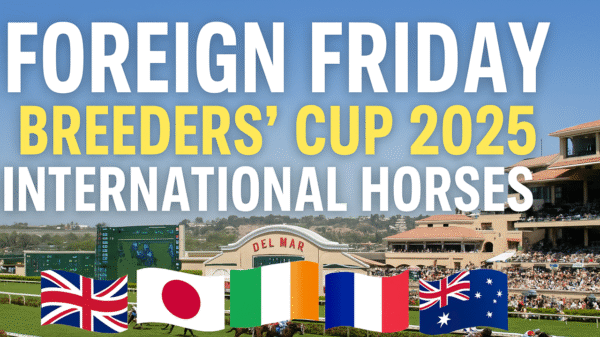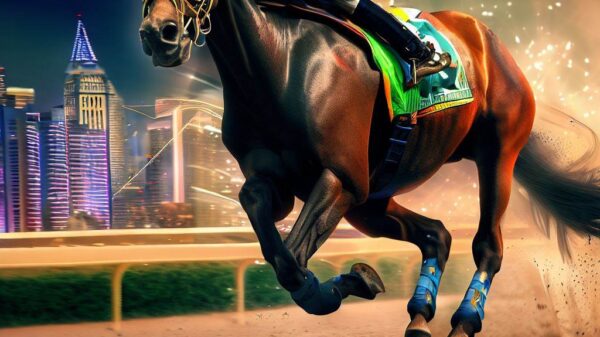As the history of the thoroughbred moves forward, we see two major undeniable changes, one related to the other. The first is that at the highest level of horse racing, horses run far less than their predecessors. The second is that horses (especially at the top levels) take much greater breaks between races—a phenomenon well connected to the first.
By way of example, Count Fleet retired after his 25-length win in the Belmont. Yet he had 21 races under his belt. Count Fleet won the Kentucky Derby on May 1, 1943, and then won the Preakness a week later on May 8, 1943. Just two weeks later, Count Fleet won the 1-mile Withers at Belmont (May 22nd), and then won the Belmont Stakes on June 5, 1943, but 2 weeks after the Withers. Whirlaway also raced in the Preakness one week after the Belmont and also had a race in between his Triple Crown bid, an allowance race after the Preakness and before the Belmont.
Here are my notes for the 2021 Preakness: It did not have the horses that crossed the finish line 2nd, 3rd, 4th, or 5th in the 2021 Kentucky Derby. Only 3 horses of the 10 horses in the 2021 Preakness field ran in the Kentucky Derby. In that 2021 Preakness, there was no winner of a major Kentucky Derby prep race: the Florida Derby, Wood Memorial, Louisiana Derby, Santa Anita Derby, or the BlueGrass Stakes. There was no horse at all from the Florida Derby. In that 2021 Preakness, only two horses that came in 2nd in a major Kentucky Derby prep were entered. Medina Spirit, who crossed the finish line first in the Kentucky Derby but was later disqualified for drugs, was 2nd in Santa Anita Derby. Midnight Bourbon was the only other horse that came in 2nd in a major Kentucky Derby prep race, with his second in the Louisiana Derby. In today’s world of one month between races, the Preakness is becoming a “must miss” for horses that did not win the Kentucky Derby, because two weeks rest is too little time according to trainers.
And then the unthinkable happened. Rich Strike won the following year’s 2022 Kentucky Derby, and though in perfectly good health, skipped the 2022 Preakness. The horse that was 3rd in the 2022 Kentucky Derby, Zandon, also skipped the Preakness. To his credit, Epicenter, the horse that was second in the 2022 Kentucky Derby, was second in the Preakness. But at this point, you would have to be blind not to see a pattern developing.
In 2023, Mage won the Kentucky Derby and was 3rd in the Preakness. But the horse that was second in the 2023 Kentucky Derby, Two Phils, did not start again until the Ohio Derby (which he won). The horse that came 3rd in the 2023 Kentucky Derby, Angel of Empire, skipped the Preakness to run in the Belmont. The horse that came in 4th, 5th, 6th, 7th, 8th, 9th and 10th in the 2023 Kentucky Derby, skipped the Preakness.
In 2024, Mystik Dan won the Kentucky and came in 3rd in the Preakness, despite media speculation he might not run. But the horses that were 2nd and 3rd in the 2024 Kentucky Derby did not run in that year’s Preakness. The horse that was 4th in the 2024 Kentucky Derby, Catching Freedom, was 3rd in the Preakness. The horse that was 5th, 6th, 7th, 8th, and 9th in the 2024 Kentucky Derby skipped the Preakness. The horse that was 10th in the 2024 Kentucky Derby, Dornoch, also skipped the Preakness. Dornoch then won the Belmont at Saratoga), perhaps setting an example for those who believe in skipping the Preakness to be well-rested for the Belmont.
In 2022, Horse Racing Nation had a story titled, “Skipping Preakness: There is a long history with Derby winners.” I am not knocking the article, in fact I am a fan of it, but it is a bit misleading. While technically it is true that there were horses that won the Kentucky Derby and skipped the Preakness, an overwhelming majority of horses that won the Kentucky Derby in the post-Gallant Fox Triple Crown era ran in the Preakness.
In the 20th Century, after Gallant Fox’s 1930 Triple Crown campaign, only nine (9) horses who won the Kentucky Derby, did not run in the Preakness. Of those 9 horses, two did not run because of injuries, and while Swaps was not planned to be run in the Preakness, injuries would have prevented him anyway. Kentucky Derby winner Hill Gail did not run in the 1952 Preakness because of injury. According to the article, “Swaps aggravated a hoof injury in the Derby, so trainer Mesh Tenney would not have run him anyway.” Grindstone also had health injuries and won the Kentucky Derby in 1996 and skipped the Preakness. So of those 9 post-1930 20th Century horses that won the Kentucky Derby but that then skipped the Preakness, only 6 were healthy enough to run. Of those 70 Kentucky Derby winners between 1930-1999, 61 actually ran in the Preakness–just over 87%.
The point of this historic analysis of yesteryear compared to today, is to point out that horse racing has changed. If the Preakness is not moved so that it is one month after the Kentucky Derby, we should only expect more of the same that we have seen in the last five years rather than what we saw in the 20th Century.
In England, there is a Triple Crown featuring the 2,000 Guineas, the Epsom Derby, and the St. Leger–the first “Triple Crown.” Like America’s Triple Crown, the races come on the calendar in reverse order from the year they were first run. Look at the following years carefully: The years that a horse won the “male” English Triple Crown were 1853, 1865, 1866, 1886, 1891, 1893, 1897, 1899, 1900, 1903, 1915, 1917 and 1918. And then the English Triple Crown horses get more spread out. After Gainsborough’s win in 1918, the English Triple Crown would not be won until Bahram in 1935 some 17 years later. (Bahram is a funny story in that he had 1/2 brother Dastur that was 2nd in all 3 English Triple Crown races.) But after Bahram, no horse would win the English Triple Crown until Nijinsky in 1970 some 32 years later. No horse after Nijinsky has won the English Triple Crown. Many commentators have pointed out that the St Leger has become its own stand-off race, and that seldom does it attract the winner of the Epsom Derby. In fact, there are few horses that try both races today. Not only has no horse won the Triple Crown since Nijinsky, no horse has won the Derby/St. Leger double since Nijinsky either.
The point I am making is that without a change in the time between the Kentucky Derby and the Preakness (and a month would be best), we may be well on the way to a situation where most of the horses that ran in the Kentucky Derby will not run in the Preakness, and there will be hopes and prayers that the Kentucky Derby winner does not skip the Preakness (even though he is perfectly healthy) to keep the Triple Crown hope alive. As I write this on May 5, 2025, there is still a question of whether this year’s Kentucky Derby winner (Sovereignty) will be in the Preakness.
In England, the English Triple Crown is effectively no more, though Camelot made a noble effort in 2012. In 2024, the horses that came in 1st, 2nd, 3rd, 5th, 6th, 7th, 8th, 9th, did not run in the St. Leger. The horse that came in 4th in the Derby, a son of Camelot named Deira Mile, was 4th in the St. Leger.
Today’s St. Leger, traditionally the third crown in the English Triple Crown, is a standalone race little related to its first two legs of the English Triple Crown. In 1800, a horse named Champion was the first horse to win the Derby/St. Leger double. Many do not know that in 1881, the American horse Iroquois won the Derby/St Leger double and almost won the English Triple Crown having been second in the 2,000 Guineas. In 1843, a horse named Cotherstone won the 2,000 Guineas, the Epsom Derby, and just missed with his second in the St. Leger. Cotherstone not only had a half-brother Munding that won the 1835 Derby, he had a full sister Mowerina, that not only was second in the 1846 1,000 Guineas, but was dam of the first English Triple Crown winner, West Australian, who did it in 1850. Mowerina (born in 1843) would be the 3rd dam of another Mowerina (born in 1876), who in turn would be the dam of Epsom Derby and St. Leger winner Donovan (born in 1886), as well as 1,000 Guineas winner Semolina. But those days of many horses going for the Derby/St Leger double are from the days of yore, Camelot more than a dozen years ago being a rare exception.
What’s the “Big Picture”? Today, like the St. Leger, the Preakness is turning into a race that stands alone, little related to the Kentucky Derby as today’s St. Leger is little related to the Epsom Derby. If the powers that be want to keep the Preakness two weeks after the Kentucky Derby, we shall continue to see a departure of the top non-winning horses in the Kentucky Derby. This is not good, for rivalries foster interest. Rivalries such as Affirmed versus Alydar, Sunday Silence versus Easy Goer, or Secretariat versus Sham, will be a thing of the past. As for the Kentucky Derby winner, it seems we will be stuck with a never-ending story, about one week after the Kentucky Derby, speculating whether a perfectly healthy winner will take a stab at the Preakness. That happened with Mystic Dan last year and is happening with Sovereignty this year.
Or the Preakness can be moved to a month after the Kentucky Derby, and the best horses in the Kentucky Derby can face each other again in the Preakness, and a perfectly healthy Kentucky Derby winner would be certainly entered in the Preakness. There is a case for keeping the Preakness two weeks after the Kentucky Derby: decades of tradition, consistency of the temporal demands of the American Triple Crown so as not to water down the accomplishments of a demanding timetable, coupled with not crowding the racing calendar with major 3-year-old races later in the race season, are reasons to keep it as is. But do the benefits of keeping the Preakness two weeks after the Kentucky Derby (tradition/maintaining the current racing calendar) outweigh the cost of the top non-winner Kentucky Derby horses skipping the Preakness and the Kentucky Derby winner being only a “maybe show”?
In my opinion, the Preakness should be one month after the Kentucky Derby, and the Belmont preferably one month after the Preakness. We will be darn lucky if there is a Sovereignty/Journalism face off in the Preakness this year, and given that both horses are healthy, that’s not good enough.
It would be reasonable to believe that I am wrong, and that the benefits of the current two-weeks gap outweigh its demerits. But that is where reasonable differences end. That said, if the Preakness is kept two weeks after the Kentucky Derby, it would be unreasonable, even outright naïve, to believe that the top non-winners of the Kentucky Derby will continue to enter the Preakness as was the case for decades, or that Kentucky Derby winner (even if healthy) might not skip the Preakness as well.
Rinaldo Del Gallo is a racing historian and fan.










